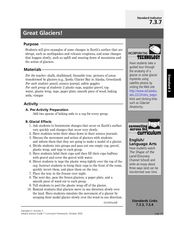Curated OER
Objects in the Sky
Young scholars explore what the sky looks like at different times. They identify objects in the sky and recognize changes over time. Students observe the sky and look for objects that are common in both the daytime and the nighttime sky.
Curated OER
Water 1: Water and Ice
Students explore forms that water can take and examine the water cycle. In this hands-on science lesson, students participate in activities that require them to change water to a solid and back to a liquid again.
Curated OER
Advanced Sentence Completion Exercise 9
In this online interactive grammar skills worksheet, students examine 10 sentences that are missing words and select the appropriate words to complete each of the sentences and match them to the sentences. Student answers are...
Curated OER
Great Glaciers!
Seventh graders study the earths surface and how changes happen to it. In this glacier instructional activity students complete a lab activity to see how glaciers form.
Curated OER
The Four Seasons with "Charlotte's Web"
Students explore the characters and plot of the story, "Charlotte's Web" through the twenty-two lessons of this unit. Characters, facts, and details of the story are recalled and discussed and form the basis of several activities in this...
Curated OER
Taking Risks: Drug and Alcohol Abuse
Students discuss a video about drug and alcohol abuse and their connection to risk-taking. They answer questions on a risk factor sheet about the use of tobacco, drugs, and alcohol. They discuss long and short term goals and how not...
Curated OER
Come to Mommy
Fourth graders participate in a simple experiment to illustrate the concept of mother bats identifying their young. They sniff stickers in order to imitate the behavior of mother bats in the wild.
Curated OER
The Movement of Ideas
Twelfth graders read and analyze the literary elements of Alphonse Daudet's "The Last Lesson" and Abraham Lincoln's Second Inaugural Address. They compare the two works and write an essay describing the reasons they feel the authors...
Curated OER
Great River Bend Adventure
Young scholars use their imagination. They discuss the 4 C's of teamwork: Concentration, Communications, Coomperation, and Consideration. Students discuss the safety guidelines of the project. They complete a rope maze. The group walks...
Curated OER
Breaking News English: Pop Star Kylie Returns to Stage in Sydney
In this English worksheet, students read "Pop Star Kylie Returns to Stage in Sydney," and then respond to 47 fill in the blank, 7 short answer, 20 matching, and 8 true or false questions about the selection.
Other
Center for Science Education: Eye on the Sky: What Makes Day and Night?
This activity will allow you to model day and night cycles. A rotating student holding a map (provided) models the earth. A lamp is used to model the sun. Numerous worksheets (pdf) and additional website resources are also provided.
Read Works
Read Works: Setting Kindergarten Unit: When (Seasons, Day, or Night)
[Free Registration/Login Required] A lesson plan, based on Look! Snow! by Kathryn O. Galbraith, in which students learn how to utilize text and picture clues to determine basic time elements of setting in a story. Students follow this...
Science and Mathematics Initiative for Learning Enhancement (SMILE)
Smile: Models of the Earth and Moon
This lesson plan from the Illinois Institute of Technology demonstrates the causes of; day and night, seasons, and phases of the moon.With a few items, you help the elementary student discover why these phenomena occur.
Science Education Resource Center at Carleton College
Serc: Mn Step: Rotation of the Earth
A KWL activity combined with a demonstration model. Students record their ideas and questions about why we have day and night. They then shine a flashlight (the Sun) on a rotating styrofoam ball (the Earth) and record their observations....
Songs for Teaching
Sciences Songs All Day Long: Nocturnal Animals
By listening to this song your students will learn all of the animals that are awake during the night. They will equate the sounds they hear at night with the animals and their sounds in the song.
Writing Fix
Writing Fix: Shape "Monsters" at Night
Using Melanie Watt's book entitled Scaredy Squirrel at Night, this multi-day instructional activity allows students to apply information about Scaredy Squirrel's night time experiences and its fears as their final product model. Students...
Climate Literacy
Clean: Zero Energy Housing
Students investigate passive solar building design with a focus solely on heating. Then they design and build their own model houses, and test them for thermal gains and losses during a simulated day and night.
TeachEngineering
Teach Engineering: Zero Energy Housing
Students investigate passive solar building design with a focus solely on heating. They learn how insulation, window placement, thermal mass, surface colors, and site orientation play important roles in passive solar heating. They use...
ClassFlow
Class Flow: Earth, Sun and Moon
[Free Registration/Login Required] In this unit children learn about the shapes and relative sizes of the Earth, Sun and Moon. Using models they learn how the three bodies move relative to each other and how these movements relate to...
ArtsNow
Arts Now Learning: Phases of the Moon [Pdf]
In this lesson plan, 4th graders use their bodies to model the day/night cycles of the Sun and Earth. Next, they discuss the moon's role in the solar system and explore the eight phases of the moon by acting out a story. Finally, a song...






















![Arts Now Learning: Phases of the Moon [Pdf] Lesson Plan Arts Now Learning: Phases of the Moon [Pdf] Lesson Plan](https://d15y2dacu3jp90.cloudfront.net/images/attachment_defaults/resource/large/FPO-knovation.png)